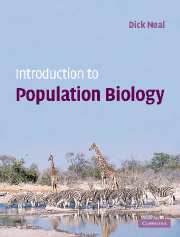Book contents
- Frontmatter
- Contents
- Preface
- Acknowledgements
- PART I Evolution by natural selection
- PART II Simple population growth models and their simulation
- PART III Population genetics and evolution
- Chapter 6 Gene frequencies and the Hardy–Weinberg principle
- Chapter 7 Mutation and the genetic variation of populations
- Chapter 8 Small populations, genetic drift and inbreeding
- Chapter 9 Migration, gene flow and the differentiation of populations
- Chapter 10 Quantifying natural selection: haploid and zygotic selection models
- Chapter 11 Applying zygotic selection models to natural systems
- Chapter 12 Polygenic inheritance, quantitative genetics and heritability
- Chapter 13 Population genetics: summary and synthesis
- PART IV Demography
- PART V Interactions between species, and the behaviour of individuals
- Glossary
- Solutions to problems
- References
- Index
Chapter 11 - Applying zygotic selection models to natural systems
- Frontmatter
- Contents
- Preface
- Acknowledgements
- PART I Evolution by natural selection
- PART II Simple population growth models and their simulation
- PART III Population genetics and evolution
- Chapter 6 Gene frequencies and the Hardy–Weinberg principle
- Chapter 7 Mutation and the genetic variation of populations
- Chapter 8 Small populations, genetic drift and inbreeding
- Chapter 9 Migration, gene flow and the differentiation of populations
- Chapter 10 Quantifying natural selection: haploid and zygotic selection models
- Chapter 11 Applying zygotic selection models to natural systems
- Chapter 12 Polygenic inheritance, quantitative genetics and heritability
- Chapter 13 Population genetics: summary and synthesis
- PART IV Demography
- PART V Interactions between species, and the behaviour of individuals
- Glossary
- Solutions to problems
- References
- Index
Summary
Before we can apply the range of equations describing zygotic selection to natural populations, we must be able to estimate the fitness of the different genotypes. This can be difficult to do in practice.
Estimating fitness and selection
We will consider three basic methods of calculating fitness for natural populations. A more complete discussion of these and some additional methods may be found in Johnson (1976).
Direct calculation of partial-generation selection coefficients
Frequently, survival or viability is measured over part of the life cycle. If we use this information to estimate fitness for our selection model, we assume that the other components of fitness, such as number of viable offspring, are the same for the different genotypes. In other words, we are assuming that the coefficients we calculate for part of the life cycle, i.e. the partial-generation coefficients, are the same as those for the full life cycle (full-generation coefficients). It should be recognized that these estimates are only approximations.
Example 11.1A sample of newly weaned mice was marked just prior to the winter, and the following spring, when they had reached reproductive age, they were live-trapped to estimate their pre-reproductive survival. Other evidence suggested that the different genotypes did not differ in their fertility or fecundity during their brief reproductive lives. Calculate the relative fitness and selection coefficients of the different genotypes from the following data.
- Type
- Chapter
- Information
- Introduction to Population Biology , pp. 166 - 185Publisher: Cambridge University PressPrint publication year: 2003



